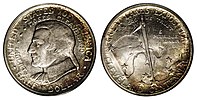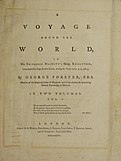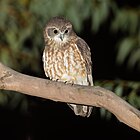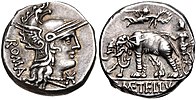Wikipedia:Today's featured article/December 2021
| << | Today's featured articles for December 2021 | >> | ||||
|---|---|---|---|---|---|---|
| Su | Mo | Tu | We | Th | Fr | Sa |
| 1 | 2 | 3 | 4 | |||
| 5 | 6 | 7 | 8 | 9 | 10 | 11 |
| 12 | 13 | 14 | 15 | 16 | 17 | 18 |
| 19 | 20 | 21 | 22 | 23 | 24 | 25 |
| 26 | 27 | 28 | 29 | 30 | 31 | |
December 1
The Cleveland Centennial half dollar is a commemorative United States half dollar, dated 1936, issued to mark the 100th anniversary of Cleveland, Ohio, as an incorporated city, and in commemoration of the Great Lakes Exposition, held in Cleveland that year. In the mid-1930s, commemorative coins were increasing in value, and Cincinnati businessman Thomas G. Melish, a coin collector, lobbied Congress to authorize several new issues, for which he would be the sole distributor. He was successful with the Cincinnati Musical Center half dollar and the Cleveland piece, and profited from both. Brenda Putnam designed the Cleveland coin, which was approved by the Commission of Fine Arts after suggestions by sculptor Lee Lawrie. Melish distributed the Cleveland coins through the exposition, at local banks, and by mail order from his office in Cincinnati. Sales were good, and the full authorized mintage of 50,000 was struck at the Philadelphia Mint. (Full article...)
December 2
Manon Melis (born 1986) is a Dutch manager of women's football development at Feyenoord and a former professional footballer who played as a forward. She spent most of her professional career playing in the Swedish league Damallsvenskan, which she won three times with her club LdB FC Malmö, in 2010, 2011, and 2013. Melis also won the Swedish Supercup with Malmö in 2011, and was the Damallsvenskan top scorer three times, in 2008, 2010, and 2011. At age 17, Melis made her debut for the Netherlands national team in 2004. Her goalscoring helped the Dutch qualify for their first major tournament, the UEFA Women's Euro 2009, where they reached the semi-finals. In the tournament, she scored a crucial goal in the final group game against Denmark to send her team into the knockout stage. When she retired from playing international football in 2016, she had earned 136 caps and scored 59 goals. She was the all-time top goal scorer for the Netherlands national team from 2010 to 2019. (Full article...)
December 3
El Tatio is a geothermal field with many geysers located in the Andes of northern Chile at 4,320 metres (14,170 ft) above sea level. It is the third-largest geyser field in the world and the largest in the Southern Hemisphere. The geothermal field has many geysers, hot springs, and associated sinter deposits. The vents are sites of populations of extremophile microorganisms such as hyperthermophiles, and have been studied as an analogue for the early Earth and possible past life on Mars. El Tatio lies at the western foot of a series of stratovolcanoes, part of the Central Volcanic Zone and the Altiplano–Puna volcanic complex, which may be the source of heat for El Tatio. There are no recorded eruptions of the Tatio volcanoes. The field is a major tourism destination. It has been prospected for geothermal power production, but development ceased after a major incident in 2009 when a drilling well blew out. (Full article...)
December 4
A Voyage Round the World is Georg Forster's report on the second voyage of Captain James Cook. Georg's father, Johann Reinhold Forster, served as naturalist on the voyage, with his son as assistant. They sailed on HMS Resolution with Cook, circumnavigating the world, and discovering islands, cultures and species previously unknown to Europeans. On their return, there was disagreement about the publication rights. After plans for a joint work between Cook and Reinhold Forster failed, Georg began writing Voyage in July 1776. It was published on 17 March 1777, six weeks before Cook's own narrative. Forster wrote it as entertaining literature, focusing not on the nautical aspects of the voyage but on scientific observations and on the cultural encounters with the peoples of the South Pacific. Critics praised the writing, especially in contrast to Cook's book. Voyage is regarded as a seminal book in travel writing and has become a classic of travel literature. (Full article...)
December 5

U.S. Route 30 in Iowa runs generally east–west for 330 miles (530 km), and is the longest primary highway in Iowa. Going east, US 30 enters Iowa at the Missouri River bridge from Blair, Nebraska, and exits at Clinton, crossing the Mississippi River. The highway runs close to the Union Pacific Railroad's Overland Route as both cross Iowa. US 30 was conceived as a part of the Lincoln Highway, the first transcontinental highway in the United States. A route through Iowa was chosen because of the important link between Omaha, Nebraska, and Chicago, Illinois, and, by 1931, it had been paved across the entire state. US 30 originally passed through many small Iowa towns, but over time, the route has been straightened, bypassing most downtown areas, and with long sections upgraded to a four-lane expressway. Since 2006, US 30 has been designated an Iowa Heritage Byway, the first highway in the state with that distinction. (Full article...)
December 6
The 1860 Boden Professor of Sanskrit election at the University of Oxford involved candidates with different approaches to Sanskrit scholarship. One was Monier Williams (pictured), an Oxford-educated Englishman and teacher of Sanskrit to those preparing to work in British India. The other, Max Müller, was a German-born specialist in comparative philology. The election came as Britain debated its role in India following the 1857 rebellion. Williams saw the study of Sanskrit as a tool in the conversion of India to Christianity. Müller saw his work as also valuable for its own sake. Both men battled for the votes of Oxford graduates through manifestos and advertisements, and received newspaper endorsements. Special trains to Oxford were provided on the day of the election, 7 December 1860, for non-residents to cast votes. Williams won by a majority of more than 220 votes. Thereafter, he helped to establish the Indian Institute at Oxford, received a knighthood, and held the chair until his death in 1899. (Full article...)
December 7
Beli Orao was a royal yacht built for the Yugoslav Royal Navy in 1938–1939. She was captured in April 1941 by the Italians during the World War II invasion of Yugoslavia by the Axis powers. Re-armed, she saw service as a gunboat in the Italian Royal Navy, briefly as Alba then Zagabria, undertaking harbour protection and coastal escort duties. She was then used to train anti-submarine warfare specialists. After the Italian armistice with the Allies in September 1943, she was handed back to the Yugoslav navy-in-exile on 7 December. Refitted, and under her original name, she became a tender for a flotilla of motor gunboats. In this role she operated out of Malta, off the western coast of Italy, and later off the Yugoslav coast. After the war she remained in Yugoslav hands under the names Biokovo then Jadranka, serving as a naval yacht, as a presidential yacht and as a dispatch boat. In 1978, she was still in service, but was scrapped soon after. (Full article...)
December 8
The 2016 Sleaford and North Hykeham by-election took place on 8 December, triggered by the resignation of Member of Parliament (MP) Stephen Phillips, a Conservative, who left Parliament due to policy differences with Theresa May over Brexit. The constituency had been held by the Conservatives since it was first contested in the 1997 general election and was considered a safe seat for the party. Sleaford and North Hykeham was estimated to have had a vote share of more than 60 per cent in favour of leaving the EU in the June 2016 EU membership referendum and Brexit was a key issue in the by-election campaign. The Conservatives nominated Caroline Johnson (pictured), a paediatrician; she won the by-election with more than 50 per cent of the vote. The UK Independence Party came second with 13 per cent of the vote, followed by the Liberal Democrats with 11 per cent and Labour with 10 per cent. The result was widely seen as poor for the Labour Party, whose vote share decreased by 7 per cent. (Full article...)
December 9
Southampton Cenotaph is a First World War memorial in Watts Park in the southern English city of Southampton. The cenotaph was the first memorial of dozens designed by Sir Edwin Lutyens to be built in permanent form and it influenced his later designs, including the Cenotaph on Whitehall in London. It is a tapering, multi-tiered pylon featuring a recumbent figure of a soldier, a prominent cross, the town's coat of arms, and two lion sculptures. In front is an altar-like Stone of Remembrance. Later cenotaphs by Lutyens, although similar in outline, were much more austere and featured almost no sculpture. By the beginning of the 21st century, the engravings on the memorial had deteriorated noticeably. They have been supplemented by a series of glass panels, unveiled in 2011, which bear all the names from the cenotaph, as well as names from the Second World War and later conflicts. The memorial was upgraded in 2015 to a Grade I listed building. (Full article...)
December 10
Prison education is any educational activity that occurs inside prison. Courses can include basic literacy programs, secondary school equivalency programs, vocational education and tertiary education. The history of and current practices in prison education vary greatly among countries. Staff and budget shortages, a lack of educational resources and computers, and the transfer of prisoners between facilities are common barriers. Studies consistently show that education in prison is an effective way of reducing the rates of recidivism, which saves the expense of future prison sentences. In the US, every dollar spent on prison education saves taxpayers four to five dollars. Despite the benefits of prison education programs, rates of education within prisons remain low in many countries, and attempts to increase the rate of and funding for prison education have been opposed. Opponents argue that prison education is a waste of money and that prisoners are not deserving of the benefit. (Full article...)
December 11
James Longstreet (1821–1904) was a Confederate general of the American Civil War. After graduating from the U.S. Military Academy he served in the Mexican–American War, where he was wounded. In June 1861, he resigned his commission to join the Confederate Army. He significantly contributed to most major Confederate victories in the Eastern Theater, primarily as a corps commander under General Robert E. Lee. Longstreet's most controversial service was at the Battle of Gettysburg in July 1863, where he disagreed with Lee and reluctantly supervised several unsuccessful attacks. Afterward, Longstreet was briefly sent to the Western Theater, but returned to the east in 1864, where he was seriously wounded by friendly fire, recovered and returned to the field. After the war he worked as a diplomat, civil servant, and administrator. In 1874 he led African-American militia troops against the White League, an anti-Reconstruction group. Many modern historians consider him among the war's most gifted commanders. (Full article...)
December 12
Dhoby Ghaut MRT station is an underground Mass Rapid Transit (MRT) interchange station on the North South, North East and Circle lines in Singapore. Located in Dhoby Ghaut, the station is beneath Orchard Road and is integrated with the commercial development The Atrium@Orchard. The station serves landmarks such as the Istana and Plaza Singapura. The only triple-line MRT interchange station in Singapore, Dhoby Ghaut station is one of the deepest and largest stations in Singapore with five basement levels. Constructed as part of Phase I of the MRT network, the station commenced operations on 12 December 1987. The North East line platforms were completed in 2003, while the Circle line platforms opened in 2010 along with Stages 1 and 2 of the line. The station features many works of art, three of them under the Art-in-Transit scheme in the North East line and Circle line stations, a pair of Art Seats at the Circle line platforms, and a piece above the North South line platforms. (Full article...)
December 13
The Sega CD is a CD-ROM accessory for the Genesis (also known as Mega Drive), produced by Sega as part of the fourth generation of video game consoles. It was released on December 12, 1991, in Japan, in 1992 in North America, and in 1993 in Europe. It plays CD-based games and adds hardware functionality such as a faster central processing unit and graphic enhancements such as sprite scaling and rotation. It also plays audio CDs and CD+G discs. The main benefit of CD technology was greater storage; CDs offered more than 320 times the space of Genesis cartridges. Sega partnered with JVC to design the Sega CD, which was redesigned several times by Sega and licensed third-party developers. By March 1996, Sega discontinued it to focus on the Sega Saturn; 2.24 million units had been sold. Retrospective reception is mixed, with praise for some games and functions, but criticism for its dearth of deep games, high price and lack of support from Sega. (This article is part of a featured topic: Sega video game consoles.)
December 14
Gianni Schicchi is a comic opera in one act by Giacomo Puccini to an Italian libretto by Giovacchino Forzano, composed in 1917–18. The work is the third and final part of Puccini's Il trittico, three one-act operas with contrasting themes, following the dramatic Il tabarro and the lyric Suor Angelica. The libretto is based on an incident mentioned in Dante's Divine Comedy. Set in 1299 Florence, the title character pretends to be a rich citizen who had died, dictating a new will in favour of the deceased's family members but especially of himself (scene in the premiere pictured). The comedy, a rarity in the composer's work, combines elements of Puccini's modern harmonic dissonances with lyrical passages such as the aria "O mio babbino caro". When Il trittico premiered at New York's Metropolitan Opera on 14 December 1918, only Gianni Schicchi became an immediate hit. It has been performed more frequently than the other two, often combined with other short operas. (Full article...)
December 15
The 1988 World Snooker Championship was a professional snooker tournament held from 16 April to 2 May 1988 at the Crucible Theatre in Sheffield. Organised by the World Professional Billiards and Snooker Association, it was the sixth and final ranking event of the 1987–88 snooker season and the twelfth consecutive World Snooker Championship to be held at the Crucible since 1977. At Preston Guild Hall, 113 players competed in a qualifying event, 16 of whom reached the final to join the 16 invited seeded players. The tournament was broadcast in the UK by the BBC, and was sponsored by cigarette brand Embassy. The winner received £95,000 from the prize fund of £475,000. Defending champion Steve Davis (pictured), who had previously won the championship four times, met Terry Griffiths, the 1979 champion, in the best-of-35-frames final. Davis won 18–11, after being level at 8–8 at the end of the first day. The event's highest break was 140 by Steve James, and there were 18 century breaks during the championship. (Full article...)
December 16
Jameson's mamba (Dendroaspis jamesoni) is a species of highly venomous snake native to equatorial Africa. A member of the mamba genus Dendroaspis, it is slender with dull green upperparts and cream underparts and generally ranges from 1.5 to 2.2 m (4 ft 11 in to 7 ft 3 in) in length. Described by Scottish naturalist Thomas Traill in 1843, it has two recognised subspecies: the nominate subspecies from central and western sub-Saharan Africa and the eastern black-tailed subspecies from eastern sub-Saharan Africa. Predominantly arboreal, it preys mainly on birds and mammals. Its venom consists of both neurotoxins and cardiotoxins. Symptoms of envenomation in humans include pain and swelling of the bite site, followed by swelling, chills, sweating, abdominal pain and vomiting, with subsequent slurred speech, difficulty breathing and paralysis. Fatalities have been recorded within three to four hours of being bitten. The eastern subspecies is twice as venomous as the nominate subspecies. (Full article...)
December 17
Hunky Dory is the fourth studio album by English musician David Bowie, released on 17 December 1971 by RCA Records. It was co-produced by Bowie and Ken Scott and featured the Spiders from Mars backing band and Rick Wakeman (pictured) on piano. The songs are melodic and piano-based, with lyrics reflecting themes of artistic reinvention and occult philosophies. It also contains three tributes to American artists. The cover artwork was inspired by actresses of the Golden Age of Hollywood. Despite positive reviews, the album initially failed to chart, becoming a commercial success following Bowie's breakthrough with The Rise and Fall of Ziggy Stardust and the Spiders from Mars in 1972. Retrospectively, Hunky Dory has been acclaimed as one of Bowie's best works and features on several lists of the greatest albums of all time. Within the context of his career, it is considered to be the album where Bowie definitively discovered his voice and style. (Full article...)
December 18
The Surrogate's Courthouse is a historic building at the northwest corner of Chambers and Centre Streets in New York City. A seven-story, steel-framed structure in the Beaux-Arts style, with a granite facade and elaborate marble interiors, it was completed in 1907. John Rochester Thomas created the original plans while Arthur J. Horgan and Vincent J. Slattery oversaw the building's completion. The exterior is decorated with fifty-four sculptures by Philip Martiny and Henry Kirke Bush-Brown, as well as three-story Corinthian-style colonnades on Chambers and Reade Streets. The building's basement houses the New York City Municipal Archives. The fifth floor contains the surrogate's court for New York County, which handles probate and estate proceedings for the New York State Unified Court System. The Surrogate's Courthouse is listed on the National Register of Historic Places as a National Historic Landmark, and its facade and interior are both New York City designated landmarks. (Full article...)
December 19
Dracophyllum fiordense, the Fiordland grass tree, is a tree or shrub endemic to the South Island of New Zealand. A heath, it is 1.5–5.0 metres (5–16 feet) tall and has tufts of distinctive long leaves at the ends of its branches. It has pyramidal flower spikes hidden under each clump of leaves, with over 100 pink flowers on each spike that later produce reddish-brown fruit. It inhabits shrubland, forests, and tussock grassland. Its range is mainly within Fiordland, Aoraki / Mount Cook and Westland Tai Poutini National Parks. D. fiordense was first described by the New Zealand naturalist Walter Oliver in 1928 and placed by him in the subgenus Dracophyllum, in a group with D. menziesii, which genetic sequencing later confirmed. In 2017, it was classed as a declining species. The kākāpō, a flightless bird, feeds on the bases of the leaves by making incisions in new shoots. D. fiordense is likely pollinated by insects and its seeds are dispersed by the wind. (Full article...)
December 20

The seventeenth season of Grey's Anatomy was ordered in May 2019, by ABC, as part of a double renewal with the sixteenth season. For the 2020–2021 U.S. broadcast television season, filming began in September 2020 while the season did not premiere until November 12, 2020, both delayed as a result of the COVID-19 pandemic. The impact of the pandemic on U.S. television only allowed seventeen episodes to be produced, the fewest of any season since the fourth. COVID-19 safety protocols were also implemented during production, and most main storylines dealt with the pandemic in the U.S. with some also connecting to spin-off series Station 19 through fictional crossover events. Numerous former starring cast members guest starred throughout the season, which received mixed reviews from critics but remained ABC's most-watched scripted series. It concluded on June 3, 2021. Despite initial uncertainty from the cast, crew, and network, the series was eventually renewed for an eighteenth season. (Full article...)
December 21
The Australian boobook (Ninox boobook) is an owl native to mainland Australia, southern New Guinea, the island of Timor, and the Sunda Islands. Described by John Latham in 1801, its name is derived from its two-tone boo-book call. Eight subspecies are recognised; three further subspecies were reclassified as separate species in 2019. The smallest owl on the Australian mainland, the boobook is 27 to 36 cm (10.5 to 14 in) long, with predominantly dark-brown plumage and prominent pale spots. It has grey-green or yellow-green eyes. It is generally nocturnal, though it is sometimes active at dawn and dusk, retiring to roost in secluded spots in the foliage of trees. The Australian boobook feeds on insects and small vertebrates, hunting by pouncing on them from tree perches. Breeding takes place from late winter to early summer, and tree hollows are used as nesting sites. The species has a large range and apparently stable population, and is not threatened. (Full article...)
December 22

"This Dust Was Once the Man" is an elegy poem written by Walt Whitman in 1871. The poem is dedicated to Abraham Lincoln, the 16th president of the United States, whom Whitman greatly admired. The poem was written six years after Lincoln's assassination in April 1865 at the hands of John Wilkes Booth. Whitman had written three previous poems about Lincoln, all in 1865: "O Captain! My Captain!", "When Lilacs Last in the Dooryard Bloom'd", and "Hush'd Be the Camps To-Day". The poem has not attracted much individual attention, though it was generally positively received and has been analyzed several times, generally as an epitaph for Lincoln. The poem describes Lincoln as having saved the union of the United States from "the foulest crime in history", a line for which conflicting interpretations exist. It is generally seen as referring to either the secession of the Confederate States of America or the assassination of Lincoln. (This article is part of a featured topic: Walt Whitman and Abraham Lincoln.)
December 23
The 1916 Texas hurricane was an intense and quick-moving tropical cyclone that caused widespread damage in Jamaica and South Texas in August 1916. A Category 4 hurricane upon landfall in Texas, it was the strongest tropical cyclone to strike the United States in three decades. Throughout its eight-day trek across the Caribbean Sea, Gulf of Mexico, and Texas, the hurricane caused 37 fatalities and inflicted $11.8 million in damage. Becoming a small tropical storm by August 12, it skirted the southern coast of Jamaica as a hurricane on August 15, killing 17 people and causing extensive damage to crops and buildings. The storm then moved into the Gulf of Mexico and intensified into the equivalent of a major hurricane on the modern-day Saffir–Simpson scale. On the evening of August 18, it struck South Texas near Baffin Bay with winds of 130 mph (215 km/h). The storm's evolution has been inferred from scant historical weather data analyzed by the Atlantic hurricane reanalysis project in 2008. (Full article...)
December 24
The Soiscél Molaisse ('Gospel of St. Molaisse') is a cumdach, a medieval Irish carrying case for a holy book, decorated in the Insular style. Until the late 18th century, the case held a now-lost companion text, meant to be carried as a pocket gospel book, as indicated by the cumdach's small size. The text is presumed to be a small illuminated gospel book associated with Saint Laisrén mac Nad Froích of the 6th century, also known as Mo Laisse. The 8th-century original wooden box was embellished between 1001 and 1025 with a silver frame, including embossed silver plates, a front piece depicting a cross, the figures and symbols of the evangelists, and Latin inscriptions. During the 15th century further silver elements were incorporated, though most have been lost. The Soiscél Molaisse is the earliest and smallest surviving cumdach. It is now in the collection of the archaeology branch of the National Museum of Ireland in Dublin. (Full article...)
December 25

The Piano Sonata No. 31 in A-flat major, Op. 110, by Ludwig van Beethoven (pictured) was published in 1822; the autograph score bears the date 25 December 1821. Though the sonata was commissioned in 1820, Beethoven did not begin work on Op. 110 until the latter half of 1821 due to factors such as his work on the Missa solemnis and his deteriorating health. The piece is in three movements. The Moderato first movement follows a typical sonata form with an expressive and cantabile opening theme. The Allegro second movement begins with a terse but humorous scherzo, which Martin Cooper believes is based on two folk songs, followed by a trio section. The last movement comprises multiple contrasting sections: a slow introductory recitative, an arioso dolente, a fugue, a return of the arioso, and a second fugue that builds to a passionate and heroic conclusion. The sonata has been recorded by pianists such as Artur Schnabel, Glenn Gould, and Alfred Brendel. (Full article...)
December 26
The Battle of Panormus was fought on Sicily in 250 BC during the First Punic War between a Roman army led by Lucius Caecilius Metellus and a Carthaginian force led by Hasdrubal. The Romans captured the major Sicilian city of Panormus in 254 BC. Thereafter they avoided battle for fear of the Carthaginian war elephants. In 250 BC Hasdrubal led out his army to devastate the crops of Rome's allied cities. The Romans withdrew to Panormus and Hasdrubal pressed on to the city walls. Once he arrived, Metellus countered the elephants with a hail of javelins from earthworks dug near the walls. Infuriated by this missile fire, the elephants fled through the Carthaginian infantry. The Roman infantry then charged the Carthaginian left flank, which broke, along with the rest of the Carthaginians. The elephants were captured and later slaughtered in the Circus Maximus (commemorative coin pictured). This was the last significant land battle of the war, which ended nine years later in a Roman victory. (Full article...)
December 27
Sesame Street research concerns the children's television show Sesame Street, which premiered in 1969. Unlike earlier children's programming, producers used research and more than 1,000 studies and experiments to create the show and test its impact on its young viewers' learning. By the end of the program's first season, the organization founded to oversee Sesame Street production, Children's Television Workshop (CTW), had developed what came to be called the "CTW model": a system of planning, production, and evaluation that combined the expertise of researchers and early childhood educators with that of the program's writers, producers, and directors. CTW utilized independent summative evaluations conducted by the Educational Testing Service during the show's first two seasons to measure the program's educational effectiveness. Based on these findings, the researchers compiled a body of data and the producers changed the show accordingly. The formative research on Sesame Street was the first time children's television viewing was studied scientifically. (Full article...)
December 28
Pepi I Meryre was the third king of the Sixth Dynasty of Egypt, ruling for more than 40 years around the second half of the 24th century BC. Pepi was the son of the dynasty's founder Teti, had at least six queens, and was succeeded by son Merenre Nemtyemsaf I. Confronted with the decline of the pharaoh's power at the expense of local officials, Pepi reacted with a vast architectural program involving the construction of temples and numerous chapels throughout Egypt, reinforcing his presence in the provinces. Egypt's prosperity allowed Pepi to become the most prolific builder of the Old Kingdom period. His external policy included military campaigns against Nubia, the Sinai and the southern Levant. Trade with Byblos, Ebla and the oases of the Western Desert flourished while Pepi launched mining and quarrying expeditions to Sinai and further afield. Pepi had a pyramid complex built for his funerary cult in Saqqara next to which he built at least a further six pyramids for his queens. (Full article...)
December 29
Ezra Meeker (December 29, 1830 – December 3, 1928) was an American pioneer who traveled the Oregon Trail by ox-drawn wagon in 1852, migrating from Iowa to the Oregon Territory with his wife and newborn son. The entire Meeker party survived the difficult six-month journey. In 1862, he settled at the present site of Puyallup, Washington, where he grew hops for brewing beer, and served as Puyallup's first mayor. An infestation of hop aphids in 1891 took much of his fortune. He made four trips to the Klondike during its gold rush, bringing groceries in an unsuccessful attempt to recoup his losses. In 1906–1908, convinced that the Oregon Trail was being forgotten, Meeker retraced his steps along the Trail by wagon despite being in his late 70s, seeking to build monuments in communities along the way. He reached New York and Washington, D.C., where he met President Theodore Roosevelt. He wrote several books, and traveled the Trail several more times, including by airplane in 1924. (Full article...)
December 30
Jamiroquai are an English funk and acid jazz band from London. Formed in 1992, they are fronted by vocalist Jay Kay, and were prominent in the London-based funk and acid jazz movement of the 1990s. They built on their acid jazz sound in their early releases and later drew from rock, disco, electronic and Latin music. Lyrically, they have addressed social and environmental justice. The band made their debut under Acid Jazz Records, but they subsequently found mainstream success under Sony. Three of their albums have charted at number one in the UK under this label: Emergency on Planet Earth, Synkronized and A Funk Odyssey. The band's 1998 single "Deeper Underground" was also number one in their home country. Jamiroquai have sold more than 26 million albums worldwide. Their third album, Travelling Without Moving, received a Guinness World Record for the best-selling funk album in history. (Full article...)
December 31
The 2010 PapaJohns.com Bowl was a postseason bowl game between the college football teams South Carolina Gamecocks and Connecticut Huskies on January 2, 2010, at Legion Field in Birmingham, Alabama; it ended in a 20–7 victory for Connecticut. Both teams had a 7–5 regular season record. Connecticut's tumultuous season had seen a victory at Notre Dame, and the murder of Jasper Howard, their cornerback. Connecticut scored twice in the first quarter: on a one-handed 37-yard touchdown reception by wide receiver Kashif Moore and then on a 33-yard field goal after South Carolina failed to convert a fourth-down play at its 32-yard line. Andre Dixon, Connecticut's running back, scored on a 10-yard rush early in the fourth quarter. South Carolina scored its sole touchdown on a two-yard run by Brian Maddox after the game had effectively been decided. Dixon was named player of the game, and finished with 126 rushing yards and one touchdown. (Full article...)


























